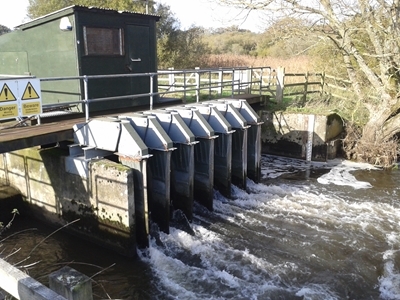Data on adult movement are collected by a Scottish Hydro-Electric (SHE) Mk Xb resistivity counter. The counter is connected to three stainless steel electrodes mounted 450mm apart on the Environment Agency venturi gauging weir at East Stoke (NGR SY 867868). The electrodes monitor the electrical resistance of the water and when a (less resistive) fish or object large enough to bridge the electrodes passes over them the system records a count.

The identity of the counts is ascertained by a combination of the pattern of the resistance change (recorded by a purpose-designed computerised waveform recording and verification system), video frame-grab and videotape analysis.
In conjunction with data on salmon movement, information on water temperature, air temperature, rainfall and light levels are also collected. Hydrological (discharge) summaries are derived from Environment Agency data. All data are collated into hourly records. Salmon results are report as both “gross” and “nett” numbers of fish ascending the counter.
Gross number refers to the total number of fish moving up over the weir irrespective of whether they subsequently drop back down over the weir. Nett numbers are the gross upstream number minus the number of downstream counts and are a more accurate indication of the fish numbers. However, nett numbers have only been recorded since 1984 and the use of both numbers gives a longer-term perspective on the population changes.
Annual numbers show that a sustained population crash occurred in 1991. Prior to this date gross numbers varied year to year with an average of 2,600. Between 1991 and 1998 the average fell to 1,300 and since 1999 has fallen still further to 800. This crash in numbers of returning adults was reflected in the majority of other rivers in the North Atlantic region and is thus of widespread concern and not a local problem with the Frome fish.
From monthly data an apparent bimodal pattern of migration is evident in most years with one “run’ in the summer and another in the late autumn. Inspection of daily records together with information on the age structure (from scale analysis and fish length analysis) of the ascending fish however reveals three major and one minor component within the seasonal pattern. The minor component in March/Apri1 is composed of 3 and 4 sea-winter fish.
In May/June there is a larger run comprising mainly 2 sea-winter fish. The grilse (1 sea-winter) run starts in June and usually peaks in July. In the late autumn there is a run of mainly stale fish of mixed age classes which have been resting further downstream in the river system. Data on the age composition of fish ascending the river shows that a river that was once famed for its multi-sea-winter component of salmon is now grilse dominated.
The influence of discharge on migration shows that between April to July most movement occurs at flows below the monthly mean. Between January to March and September to November the fish move on flows higher than the monthly mean and have a positive association with discharge. The timing of the higher river flow that triggers the autumn migration appears to be critical. Spates before mid-October rarely instigate a large run of fish whereas later, lower intensity spates do trigger an upstream migration.
Time of day of movement also varies over the year with summer (May to August) migrating fish moving principally during the night and dawn periods. Conversely, during the winter (October to January) movement occurs all through the day with some months having greater movement during daylight hours.
Counter data has also shown that data from rod catch does not give consistently good estimates of annual numbers but can give indications of major population declines. Differential rod exploitation of the different sea ages of adult fish is also apparent.